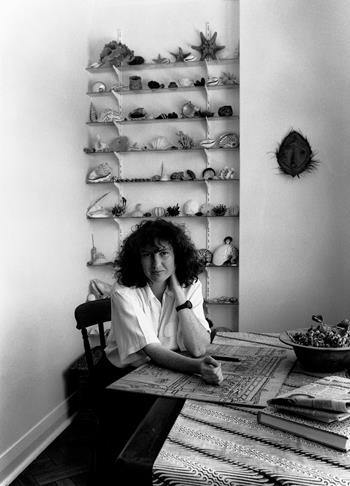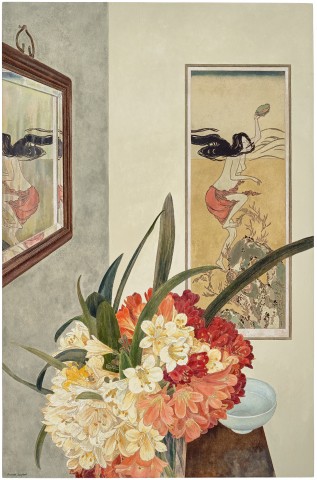JAPANESE PRINT AND CLIVIAS, 2013
CRESSIDA CAMPBELL
watercolour on incised woodblock
146.0 x 95.5 cm
signed lower left: Cressida Campbell
Philip Bacon Galleries, Brisbane
Private collection, Queensland, acquired from the above in 2013
Cressida Campbell, Philip Bacon Galleries, Brisbane, 9 July – 3 August 2013 (illus. in exhibition catalogue, np)
Margaret Olley: painter, peer, mentor, muse, S. H. Ervin Gallery, Sydney, 7 January – 17 March 2017
Cressida Campbell, Hamilton Art Gallery, Victoria, 11 May – 7 July 2019 (illus. exhibition catalogue cover)
Porter, R., Margaret Olley: painter, peer, mentor, National Trust of Australia, Sydney, 2017, pp. 92, 93 (illus.), 114
Japanese Print and Clivias, 2013, unique colour woodblock print, 145.5 x 94.5 cm, Deutscher and Hackett, Melbourne, 21 April 2021, lot 11
210136.jpg

Accomplished print maker and painter, Cressida Campbell conjures images whose prosaic subject matter conceals their meticulous conception. These are testaments to the artist’s sophisticated visual intelligence and her humble appreciation for the small wonders of the world around her, this shared human experience delighting collectors. In this large and masterful painted woodblock, Japanese Print and Clivias, Campbell combines several elements within a view of a hallway of her house in Bronte: a detailed floral still life of clivia flowers, a view of a framed Japanese Ukiyo-e print and its reflection in an adjacent mirror. Through a delicate orchestration of the grooves and furrows of an incised plywood block, and the chalky deposits of watercolour left on its surface, the artist conveys a wide range of colours and textures: from the waxy leaves of the plants to the shining glaze of a ceramic bowl and pearlescent reflections on the beveled hallway mirror. This is Cressida Campbell at height of her technical proficiency, delighting in the intellectual game of representing pictures in pictures, in an artistic process that itself requires a mastery of reflected images.
Drawing artistic inspiration from her immediate environment, Campbell’s work is inherently autobiographical. Her interiors and still lives are filled with objects and curiosities, fragments of artworks from the artist’s own collection and other bibelots, each chosen for their aesthetic value. They lend insight into what has shaped Campbell’s harmonious decorative style and provide motifs that are carried throughout her oeuvre. As John McDonald wrote, to qualify Campbell as a decorator is no insult, despite the word’s current pejorative connotations, as ‘she is a decorator in the same manner as Matisse or Bonnard … in bringing us back to simple things, Campbell is exploring a decorative art for our times … the vital difference is that her prints almost radiate with the pleasure of their own making’.1 In certain special instances, a work of Cressida Campbell’s will contain a secret, personal story pertaining to the artist’s life, her friends and associates, and the pursuit of beauty that stimulated them all.
In 2017, Japanese Print and Clivias was chosen by the artist to illustrate her enjoyment of representing ‘pictures within pictures’, a practice that she shared with her artistic mentor, Margaret Olley, in an exhibition dedicated to Olley and peers.2 The Japanese print referred to in the title of this artwork is in fact a silkscreen copy of a rare Ukioy-e print of a Japanese abalone diver.3 This facsimile was created by John Coburn’s daughter, Kristin, for Campbell’s old friend, the artist Martin Sharp, who had owned and then lost the rare print in the 1980s.4 In contrast to the cossetted courtesans and geishas of other ukiyo-e prints, the ama abalone divers were women liberated from societal expectations. In Japanese Print and Clivias, the diver inhabits many planes, travelling between the underwater world, the surface, and another, more surreal plane in the mirrored surface, her hair flowing in invisible currents. Bright and crisp, the colours of this painted woodblock are painstakingly observed and applied, from the coral pink and cream coloured blossoms to the pearlescent grey reflections in the pane of glass.
This woodblock, since its initial exhibition at Philip Bacon Galleries in 2013 where it was purchased by the current owner, has been loaned to two temporary exhibitions – at S.H. Ervin Gallery in Sydney in 2017 and then to the Hamilton Art Gallery survey show of Cressida Campbell’s work in 2019, where it was reproduced on the cover of the catalogue. Its related work, the unique print of Japanese Print and Clivias, was sold at Deutscher and Hackett in April 2021 for a record price for a work on paper by Cressida Campbell.
1. McDonald, J., ‘The Woodblock Painting of Cressida Campbell’, in Crayford, P. (ed.), The Woodblock Painting of Cressida Campbell, Public Pictures, Sydney, 2008, pp. 17 – 19
2. The artist, 2016, cited in Porter, R., Margaret Olley: painter, peer, mentor, National Trust of Australia, Sydney, 2017, p. 92
3. The attribution of the original artwork is disputed. While some scholars believe that this artwork was created by the master Hokusai, others relate it to Kitagawa Utamaro’s Awabi-Tori suites from c.1788 – 1790
4. Story relayed both in Martin Sharp’s biography (see Tarling, L., Sharper 1980 – 2013, ETT Imprint, Exile Bay, NSW, 2017, pp. 96 – 97) and by Cressida Campbell in Porter, R., Margaret Olley: painter, peer, mentor, National Trust of Australia, Sydney, 2017, p. 92
LUCIE REEVES-SMITH
